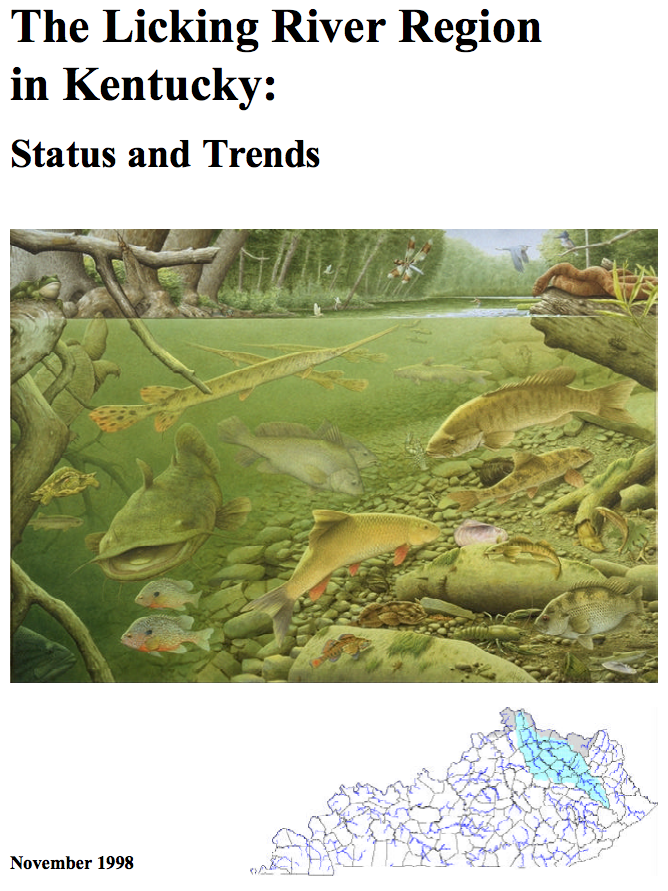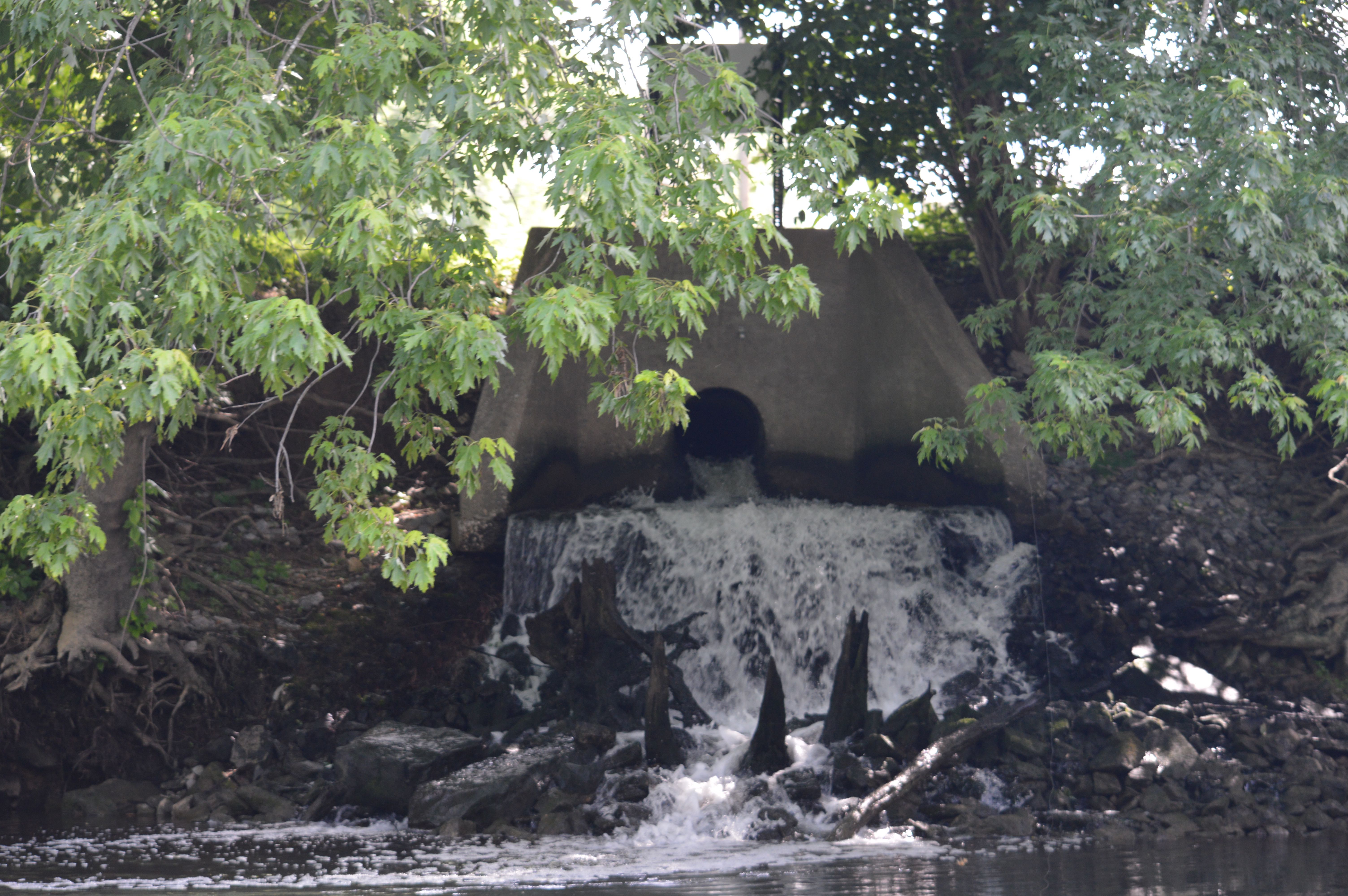Part four of a seven part series
The Licking River begins with a whimper on its 300-mile plus journey north from headwaters in the mountains of Kentucky to its crescendo as it converges with the Ohio River at metro Cincinnati. Veteran reporter Andy Mead undertook his journey in an aluminum canoe, braving the elements on and off over more than a year, to experience himself the good, the bad, the ugly and the spectacular of a river that runs through nearly every culture, geography, economy, environment and society known to its home state. Along the way he talked to dozens of experts – from ecologists, scientists and environmentalists to historians, farmers and fisherman – and met dozens of real Kentuckians whose lives are entwined with the river. Thanks to support from the Northern Kentucky University Ecological Stewardship Institute, the Kentucky Center for Public Service Journalism, the UK Scripps Howard First Amendment Center and KyForward.com for making possible the story of this incredible river.
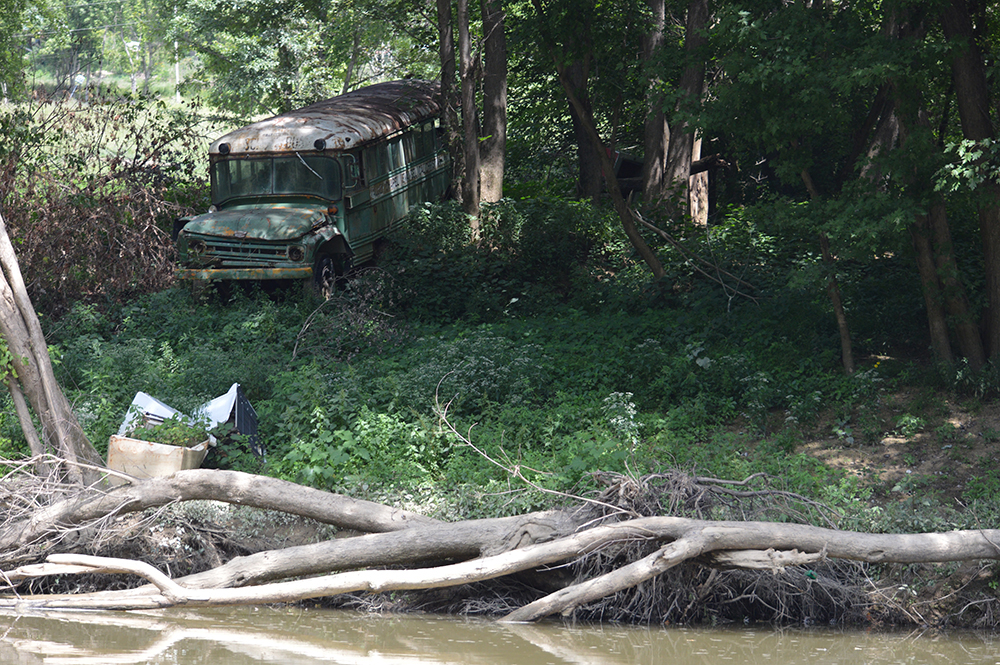
An abandoned bus slowly succumbs to years of neglect on the bank of the Licking River (Photo by Andy Mead)
By Andy Mead
KyCPSJ Senior Reporting Fellow
MOUNT STERLING – As they had every year for 15 years, Barry Tonning and Larry George were spending a beautiful fall day sloshing about in the water as they took samples from Hinkston Creek, a tributary of the Licking River.
They were in an empty pasture, wearing waterproof boots, as they dipped out small vials of water to test for things such as dissolved oxygen, which aquatic life needs to survive, and conductivity, which measures how well the water conducts electricity (a significant change in conductivity can signal that pollution is present).
“The water looks pretty good today,” Tonning said as they started. “But you never know; looks can be deceiving.”
Tonning and George are members of the Licking River Watershed Watch, a volunteer group that tests water quality in 19 counties along the Licking River basin.
The Licking River has its beginnings as a trickle in Magoffin County in Eastern Kentucky. It winds its way for 300 miles before it pours into the Ohio River across from the Great American Ballpark in Cincinnati. That means it has its beginnings in the coalfields, runs through forests and farmland, flows through a dense urban area in Northern Kentucky and dumps into the Ohio River.
And that means there are plenty of opportunities for abuse.
Tonning was the principal author of “The Licking River Region in Kentucky: Status and Trends,” a 1998 report coordinated by the state that was the first comprehensive, layman-friendly look ever taken of the health of the river.
Tonning, who has had a variety of careers, including newspaper reporter and economic development planner for a Native American tribe, for the past four years has been employed by an international engineering and consulting firm and has worked on projects on Hinkston Creek. If you start asking about water quality in the Licking River basin, you’re likely to be pointed his way.
The 1998 report said that most of the streams that feed into the Licking “seem to be free of excessive pollution.” It noted, however, that some tributaries were “contaminated with bacteria from sewage or livestock; silt from erosion, construction or logging; algae blooms fed by nutrients from fertilizers or manure, and some pollution from mining and industrial or urban sewage plants.”
It happens that the Status and Trends report came out the first year that Tonning, George and other Watershed Watch volunteers started collecting samples in the Licking River basin.
So, standing in the empty cow pasture with his boots in a stream, Tonning was asked how the river and its tributaries are faring today.
“We’ve seen gradual improvement over the years, there’s no question about it,” he said. “It’s an incremental thing.”
Tonning is not alone in this assessment. Marc Hult, a retired U.S. Geological Survey hydrologist who lives beside the Licking in Covington and is considered THE expert on the river, said “On quality, I think we’ve made progress on a whole range of issues.”
Quantifying that improvement is difficult.
Looking at the numbers
In a study conducted in conjunction with this series, Alexis Sharp, a Northern Kentucky University environmental science senior, looked at water quality readings that Watershed Watch volunteers gathered from 1998 to 2013. She conducted her research under the direction of Kristy Hopfensperger, an assistant professor of biological sciences.
Sharp’s study took a wide view of the condition of the river in that it averaged many testing sites over 15 years. That included streams that drain forests and streams that run through cow pastures. It included dry years and wet years, which can strongly impact sampling for water quality.
Her finding: There has been little change.
“You can’t say the river has gotten worse. . .it hasn’t gotten better either,” Sharp said in an interview.
In most of the measurements, such as dissolved oxygen, Sharp found that the Licking overall meets standards set by the federal Environmental Protection Agency.
Where the Licking failed badly was in high fecal coliform levels, a finding that Sharp called “a little alarming.”
Fecal coliform is an indicator of feces in the water. The feces could come from cows standing in a steam, deer running through the woods, dogs living in suburban neighborhoods or geese congregating on a golf course. It also could come from humans, through a faulty septic tank, a straight pipe that carries waste directly from a bathroom to a stream, or an urban sewer system that dumps raw sewage in the river after heavy rains.
The Licking River basin has all of those things.
Randy Payne, an environmental scientist with the Kentucky Division of Water, says that fecal coliform and E. coli bacteria are the top causes of pollution in the Licking.
The pollution levels are so high in the lower portion of the river that the Division of Water and the state Department for Public Health have started every summer since 1999 with a joint warning that people should not swim in or have skin contact with the water. (Because the Licking River flows generally north, the “lower” part of the river is also the northernmost, close to the confluence with the Ohio River.)
The swimming advisory covers all of Banklick Creek and Three Mile Creek, and the main stem of the Licking from the Banklick to the Ohio River.
“Some improvement in the concentrations has been observed in the more rural areas, but the overall water quality continues to support the need for an advisory,” Payne said in a written response to questions for this article.
(The Licking is not the only Kentucky waterway with this dubious distinction. There are similar swimming advisories for parts of the main stem and some of the tributaries of the Upper Cumberland River and part of the North Fork of the Kentucky River.)
A number of tributaries of the Licking also have tested high for E. coli, but Payne says those areas have limited monitoring and don’t rise to the level that require advisories. He notes that state water and health officials warn against swimming in any stream – in the Licking basin or elsewhere – after a rain, or within several miles of cities, suburban neighborhoods, or areas with heavy agriculture.
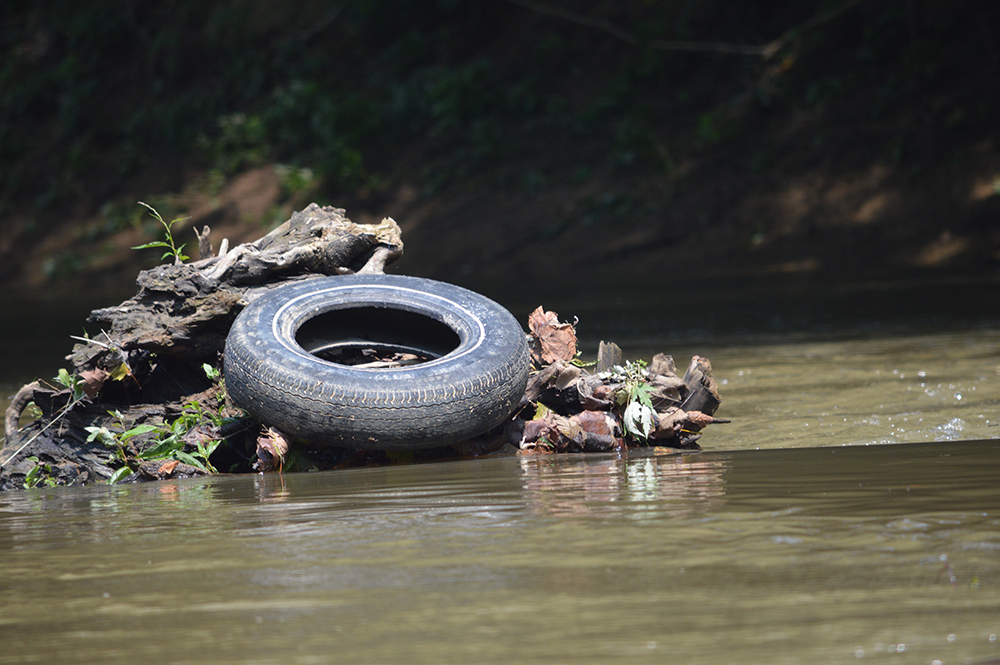
Pollution levels are so high in parts of the Licking that the Division of Water and the state Department for Public Health routinely issue annual advisories against entering the water (Photo by Andy Mead)
Payne pointed to a study by the U.S. Geological Survey that looked at statewide Kentucky water quality from 1979 to 2004. Most of the sampling sites for the Licking River showed conditions largely unchanged, with two exceptions: Most showed an increase in chloride, which could possibly show an increased use of road salts, or the effects of coal mining, or oil and gas well drilling. About half the stations showed steady or decreasing trends for fecal coliform.
The most recent report on Licking River basin water quality came out in October 2014. But it’s called the 2012 Integrated Water Quality Report, and covers the testing that ended in the spring of 2011.
It measures whether the river and its tributaries are suitable for aquatic life, primary or secondary skin contact, water supply and fishing.
The good news from the report is that all of the nearly 33 miles tested for fishing and the 87 miles tested for drinking water supply were OK.
But less than 40 percent of the 956 miles tested for aquatic life were found to be fully supporting things that live in the water. That was about 8 percent higher than the previous report two years earlier.
And less than 20 percent of the 589 miles tested for primary skin contact were found to be fully safe to touch. That’s 11 percent higher than the 2010 report.
While that appears to be a trend heading in the wrong direction, Payne argues that it is not. The change for the worse is, he said, because the state is concentrating on testing the worst places.
“The primary reason for the stream miles not fully meeting those designated uses is a result of the monitoring effort that increased in watersheds of already known impaired streams in the basin,” Payne said.
Payne’s overall impression: “Indications are the Licking River basin is holding its own.”
Cows, sewage and tobacco

Removing livestock access to the Licking watershed in an effort to control contamination remains a long, expensive and difficult process (Photo by Andy Mead)
People involved in improving water quality say it can be a very slow process. Take the elimination of straight pipes, which carry raw wastes from bathrooms to streams. They are illegal. But enforcement of laws against them can be difficult because solutions require expensive fixes in poor areas of the state, and because they are often found in rugged rural areas where a standard septic system may not be feasible.
No one knows how many there are in the Licking River basin, but the number probably is lower than it once was. After a flurry of concern in the late 1990s, programs were started that helped homeowners replace straight pipes with constructed wetlands or other means of dealing with waste, or hooked homes to pipes that led to treatment plants. And a state law was passed that required proof of an acceptable sewage disposal method before electricity could be turned on at a new residence.
Meanwhile, millions of federal and state dollars have helped repair old sewer lines, eliminate often-faulty package treatment plants and build new wastewater treatment plants.
The pasture where Tonning and George were taking samples was, for example, downstream of Mount Sterling, were bacteria from leaking pipes and an old treatment plant used to show up in the water tests.
Now, Tonning says, the pipes have been repaired, and the new Mount Sterling Wastewater Treatment Plant, farther downstream from the old plant, is doing a much better job treating wastes.
But high fecal coliform spikes can still be found along the creek, and Tonning says that has been frustrating. One spot with high readings is near a sewer pump station, but it also is near an area where cows have been seen standing in the water.
“Unfortunately, a small number of cattle standing upsteam from a sampling location can cause extremely high bacteria readings,” Tonning said.
Getting those cows out of streams is a long and expensive process, but it is happening.
In Bourbon County, farmer David DeMarcus took advantage of a government program that allowed him to put up fences to keep cattle out of Blacks Creek at the point where it meets Hinkston Creek. He paid 25 percent of the project costs, and the rest came from federal and other sources.
The project involved nearly 9,000 feet of fence, making water available away from the stream, and a crossing that allowed cattle to get from one side to the other.
“It saves the banks of the creek,” Demarcus said. “The cattle will get in there and pretty soon you have erosion.”
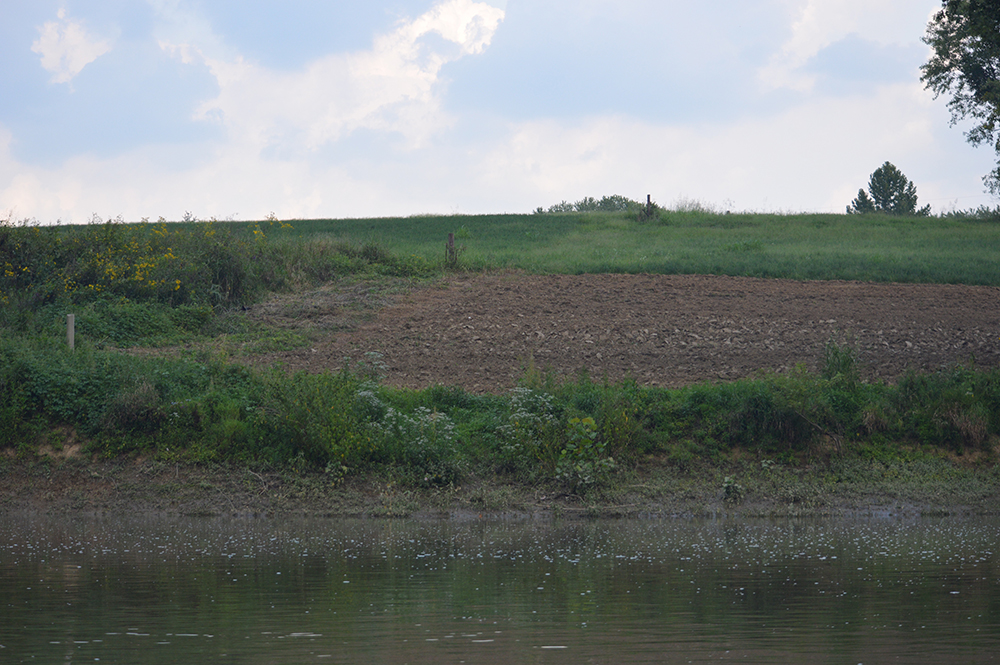
The reduction in acres plowed each year for tobacco has resulted in more land covered with grass, reducing the amount of sediment washing into the Licking River (Photo by Andy Mead)
Valerie Tipton, the Bourbon County conservation technician who worked with Demarcus on the project, said the project was part of a $150,000 grant a few years ago that is being followed by a current $225,800 grant.
Fencing keeps the cows from defecating or urinating in the water and provides a buffer strip that helps catch pollution before it reaches the stream, Tipton said. As a side benefit, it provides streamside habitat for wildlife.
Both Tonning in Mount Sterling and Marc Hult in Covington said that farmers have made significant progress in keeping cattle out of streams and using less fertilizer, herbicides and pesticides.
And they both mentioned a major change in Kentucky’s agriculture that has helped water quality – the reduction in acres plowed each year for planting tobacco. Those fields are now more likely to be covered with grass, which means less sediment washing into the river.
The Lower Licking
The Licking runs into some of its worst water quality programs when it hits the urban sprawl of Northern Kentucky. So when Pamela Fisher’s Public Affairs Reporting journalism class at NKU was looking for a project on which to concentrate, they chose something close by – water quality in their back yard.
Amber Coakley, for example, examined how pollution impacted the river.
Farmer Jim Fields told her that the salamanders he used to catch as a kid were disappearing. Jeff Joerning, owner of a Cold Spring restaurant called One More Bar, talked about the lingering stench of occasional algae blooms on the river.
For her research, Amber Hemmerle wrote about Sanitation District 1’s efforts to correct a decades-old problem of “combined” sewer systems that are designed to catch rainwater runoff, domestic sewage and industrial discharges in the same pipe. The problem is that after a heavy rain, the volume is more than the pipe can carry to a treatment plant, so raw sewage runs into the river and its tributaries.
The federal Environmental Protection Agency sued, and in 2007 the sanitation district agreed to spend more than $880 million over a couple of decades to fix the problems.
Jamie Holtzapful, director of communications for SD1, said that agreement was based on a “very preliminary cost estimate.” After more study, she said, the agency found it would require more work and cost more. SD1 now is negotiating with the EPA for more time to spread out the cost and complete the work.
Holtzapful said she did not have information on a new deadline or cost estimate because negotiations are still under way.
Millions of dollars already have been spent on new sewer lines and pump stations aimed at reducing sewage overflows and several projects are under way. In some places, “green technology” has been used to improve water quality. Along Banklick Creek, for example, six acres of wetlands have been constructed. A small pump pulls some polluted water from the creek and diverts it into the wetlands, where natural processes clean the water.
In Covington, terraced berms were built in the Interstate 71/75 right-of-way and planted with trees, shrubs and grasses. The project slows the runoff of rainwater, which means fewer sewer overflows.
At one point, sewage overflowed at 193 locations after heavy rains. That number now is 164 and dropping, Holtzpaful said.
The overall goal, she said, is to reduce not only the amount of sewage flowing in the Licking and Ohio rivers, but also the amount of fertilizer, oil and animal waste in storm water runoff.
Hemmerle wrote about some of the “green infrastructure” projects the district is trying, such as working with transportation officials to create green medians that catch and filter runoff.
The “gray infrastructure” projects, mostly larger pipes, have been considerably more expensive. A Cincinnati Enquirer analysis determined that, adjusting for inflation, sewer fees have increased 291 percent since 2000. And raw sewage still pours from 180 locations after a heavy rain.
Sewers have become a major political issue in Northern Kentucky, and the district is in discussions with the EPA about getting more time to make repairs.
Meanwhile, the “no skin contact” warnings are sent out each year.
A ray of light is that levels of dissolved oxygen have risen.
The situation was so bad in 2000 that the EPA added the lowermost section of the river to its list of impaired waters.
Since then, conditions have improved. The EPA says that is due in large part to federal Clean Water Act funds spent on tributaries miles away.
The agency said that $900,000 went into efforts on Townsend Creek, $680,000 on Strodes Creek, and $1.6 million on Fleming Creek. Most of those projects involved keeping cows out of creeks and providing another source of water.
Tonning said a lot of people are involved in making the waters of the Licking River basin cleaner. They include state and federal agencies, University of Kentucky extension agents, The Nature Conservancy, Watershed Watch groups and others.
He would like to see more done, more money for conservation efforts, perhaps a 75 percent property tax break for letting vegetation strips grow along stream banks.
“We’re only about 10 to 15 percent of where we need to be, but that’s nine to 14 percent further than where we were,” he said.
“So, it took us what, 300 years, to cause the problem? It’s going to take us 50 to 100 years to get things completely turned around, but there’s been a lot of progress.”
Andy Mead
Senior Reporting Fellow
Andy Mead retired from the Lexington Herald-Leader after 34 years, where he distinguished himself as a reporter, with a particular interest in the environment. He also worked at the Boca Raton News for four years before coming to Lexington. He grew up in Savannah, Ga. and graduated with a master’s degree in history from Florida Atlantic University. He is a widower, living in Lexington, and has twins who are college students. As Senior Reporting Fellow for KyCPSJ on the Licking River project, he worked closely with NKU’s Ecological Sustainability Institute and engaged with faculty and students at NKU as a guest speaker and visiting professional-in-residence.




